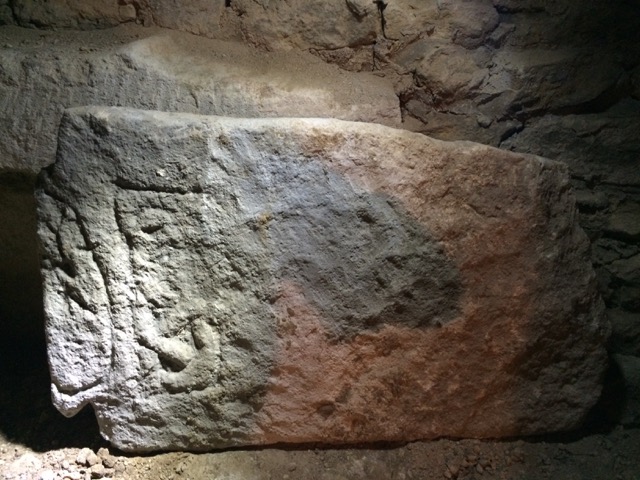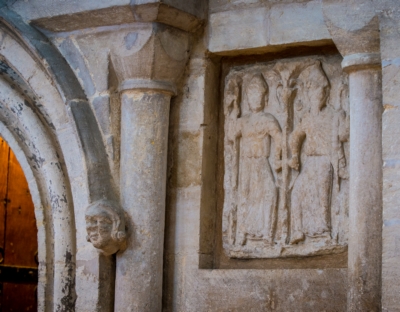Cathedral Archaeologist Dr Jackie Hall shares some insights arising from the British Archaeological Association's national conference in Peterborough in 2015.
Something lost
Dr Stephen Upex, a well known authority on Roman history, told us after the conference about a collection of photographs he had come across at Peterborough Museum, depicting Anglo-Saxon stones from Peterborough Cathedral.
We can locate most of the stones in these photographs at the Cathedral except one - a highly important missing fragment from a 10th or 11th century rood (crucifix). The feet are shown without nail marks which is typical for a figure of the crucified Christ from this period.
This stone has not been seen or heard of since the photograph was taken, probably sometime in the 1990s. It may well have been borrowed for legitimate research so if anyone has other photographs of it, or knows anything about it, I would love to hear from them (contact me via the Cathedral Office).
Something found
 The foot fragment may have gone missing but another stone that I have been looking for for years turned up in November during research following the conference!
The foot fragment may have gone missing but another stone that I have been looking for for years turned up in November during research following the conference!
I was taking a group of scholars around the Anglo-Saxon foundations when we turned over a very undistinguished looking stone. It turned out to be an Anglo-Saxon gravestone that had been discovered in 1888-9 underneath the west wall of the North Transept. It had stood at the foot of an interlace gravecover and is a rare example of an in situ footstone.
More exciting still, it is a piece of re-used Roman stone known as an ansate slab, which would have born an inscription and had “handles” (ansae) on each side. Although none of the inscription remains, one of the “handles” is quite visible. This adds to the small body of evidence (including a considerable quantity of reused Roman stone) suggesting some sort of Roman monument or building stood in the area of the Cathedral Precincts.
A new theory about the "dancing bishops"
 Many people will be familiar with the stone tablet set into the wall of the South Transept, near to the Sacristy door, which is often referred to as the “dancing bishops”.
Many people will be familiar with the stone tablet set into the wall of the South Transept, near to the Sacristy door, which is often referred to as the “dancing bishops”.
This piece has long been thought of as Anglo-Saxon, probably dating to the 8th century – about the same time as the Hedda stone which can be seen at the east end of the Cathedral. However, Romanists at the conference, notably Dr Martin Henig, wish to claim the figures for the Roman world.
Although the jury is still out, he makes a strong case regarding the iconography, suggesting that the stone probably depicts local deities using Roman models such as Bacchus and Ariadne, or Neptune and Minerva.
Jackie Hall, Cathedral Archaeologist
Community archaeology in June 2016
Read more about the Community Archaeology dig in 2016.
In June this year (2016), as part of the Heritage Lottery funded project at the Cathedral, a community dig will take place in a former garden in the northwest part of the Precincts.
Cathedral Archaeologist Jackie Hall, and Schools and Families Officer Alex Carton, will be working with Access Cambridge Archaeology and the Cambridge Archaeological Unit (both part of the University of Cambridge) to excavate a number of trenches, roughly 2 metres wide and 10 metres long.
Geophysics in the area designated for the dig has shown a number of features of interest. It is known from historical records that there was a large pond in this area for hundreds of years, perhaps originally serving the medieval monastery.
School pupils and undergraduates from University Centre Peterborough will be involved in the dig. There may also be some opportunity for individual volunteers. For more information please contact the Volunteer Coordinator Lisa Foulkes-Arnold via Volunteer.Coordinator@peterborough-cathedral.org.uk or on 01733 355316.
This article was posted in March 2016